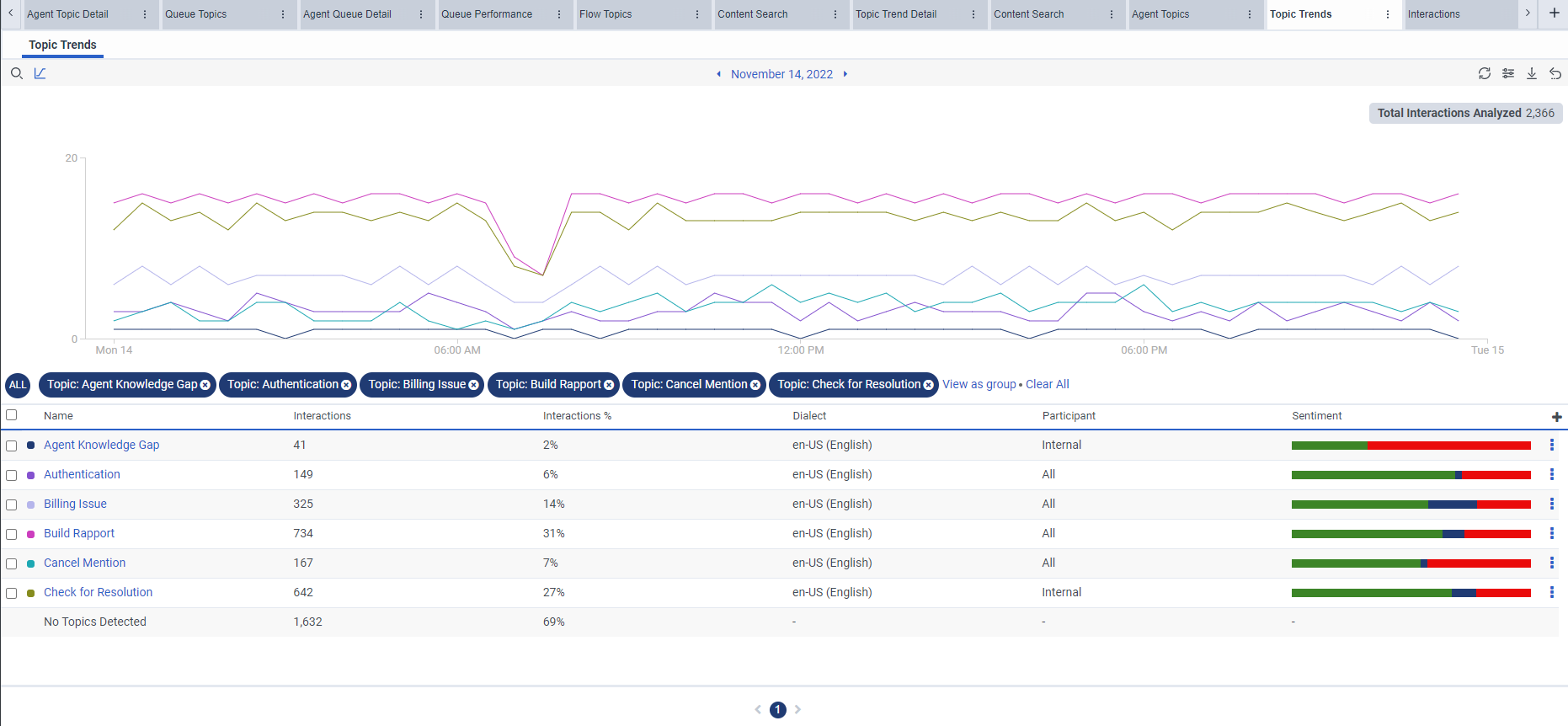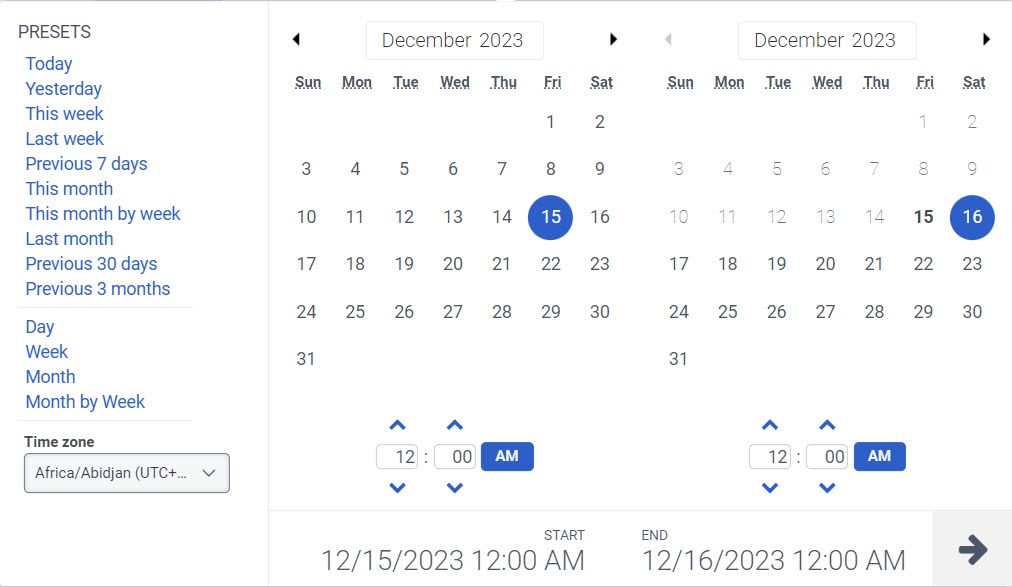Topic Trends Summary view
Prerequisites
The following permissions:
- Analytics > Speech and Text Analytics Aggregates > View
- Speech and Text Analytics > Topic > View
To search for topic trends in interactions with transcripts, click Performance > Workspace > Speech and Text Analytics > Topic Trends.
To search for topic trends in interactions with transcripts, perform the following:
- Click Menu > Analytics > Analytics Workspace.
- In the Default section, search for Topic Trends and then click the view name to open it.
The Topic Trends summary view displays a list of topics from transcripts of conversations between external (customer) and internal (IVR, ACD, agent, conference, or voicemail) participants, based on filter criteria. Interactions with no topics are summarized in the No Topics Detected row.
Available columns
To view the available columns, see the Topic Trends Summary view section in the View available columns in performance views by category article.
- To view the consolidated list of available columns in the performance views, see Consolidated view of available columns in performance views.
- To view the list of available columns in the performance views by category, see View available columns in performance views by category.

For more information about a topic, click the row to view the Topic Trends Detail view.
Set a default time zone in the workspace
You can set the default time zone in the analytics workspace before viewing any analytics view.
To set the default time zone in the workspace, follow these steps:
- Click Performance > Workspace.
- Click Menu > Analytics > Analytics Workspace.
- On the left side, from the Time zone drop-down menu, select the required time zone as the default time zone for the analytics workspace.
To save the view with your filter and column settings, click Save .
To export the data in the view, click Export .
This view does not update as new interactions occur. To see new interactions, click Refresh .
In the Topic Trends Summary view, you can drill down to Content Search to view details about each topic in the list. To open the Content Search view associated with a specific topic, click the icon and select the icon. The content search view includes the same filters used in the Topic Trends Summary view.
Customize the view
To show only certain data, customize the Topic Trends Summary view. For example, you can choose to show only certain columns or filter to see certain topics. Your customizations remain in effect even if you leave and return to the view. You can also save your filter and column settings as a saved view to quickly switch between different data of interest in the same view.
- In the top left corner of the topic list, click Filter .
- In the field provided, type the topic name or the dialect for which you want to filter the topic list.
To customize analytics views, use the date filter.
To filter metrics by date or configure a custom date range, use presets. When filtering metrics for this view, select any custom date range up to one year.
To use a preset to filter metrics, complete the following steps:
- To display the date filter, click the date.
- In the Presets list, select a preset date option.
Date presets
| Presets | Description |
|---|---|
| Today | Shows data for the time period that includes the current interval. |
| Yesterday | Shows data for the previous day. |
| This week | Shows data for a Sunday through Saturday time period. |
| Last week | Shows data for the previous week, Sunday through Saturday. |
| Previous 7 days | Shows data for the previous seven days. |
| This month | Shows data for the current month, with no extra days. |
| This month by week | Shows data for the current calendar month starting on Sunday and ending on Saturday, including extra days if the month does not start on Sunday or end on Saturday. |
| Last month | Shows data for the previous calendar month with no extra days. |
| Previous 30 days | Shows data for the previous 30 days. |
| Previous 3 months | Shows data for the previous three months. For example, Nov 1, 2022 – Jan 31, 2023. |
| Day | Shows data for a single 24-hour day. |
| Week | Shows data for a Sunday through Saturday time period. |
| Month | Shows data for the exact month with no extra days. If the current month is selected, you can see the data up to the current date. |
| Month by Week | Shows data for a calendar month starting on Sunday and ending on Saturday, including extra days if the month does not start on Sunday or end on Saturday. |
- To use a custom date range to filter metrics, complete the following steps:
-
- Click the date to display the date filter.
- Select a start date and an end date on the calendar, and click the filter arrow .
- To view data for a different time period using the same date presets, click the arrows on either side of the date display. For example, to view data for the previous day, click the Day preset, and then click the arrow on the left side of the date.
- To view data for a different time zone using the same date presets, from the Time zone drop-down menu, select the required time zone. You can create and save reports with the same selected time zone.
- To filter by media type, click the Filter icon .
- Select the media type.
The selected media type icon is displayed above the column headers. For more information about various media types and their settings, see the Set behavior and thresholds for all interaction types section in the Create and configure queues.
Data in the view can be displayed in a chart. To view the chart, click the Show/Hide chart icon .
To show or hide columns:
- At the top right corner of the columns, click the Pick columns icon. The Add/Remove Column pane appears.
- Click the Manage columns tab.
- (Optional) To sort the columns in ascending or alphabetical order, click Sort by > Column Name A-Z.
- (Optional) To sort the columns in descending or reverse alphabetical order, click Sort by > Column Name Z-A.
- (Optional) To categorize or uncategorize the columns, click Sort by and enable or disable the Group by Categories toggle.
- Search or scroll to select the columns you want to view. Note: You can also use keyboard navigation to choose the columns.
- Click Save. The selected columns appear on the screen. Note: The column selections appear only after saving the changes and do not apply to the table immediately.
To reorder the columns within the column picker:
- At the top right corner of the columns, click the Pick columns icon. The Add/Remove Column pane (column picker) appears.
- Click the Reorder columns tab.
- Click the grid icon
 of a column, and then drag and drop to reorder it within the column picker.
of a column, and then drag and drop to reorder it within the column picker.
- Click to select the grid icon of the column to be reordered, and on the keyboard, press the Spacebar.
- To position the column, use the Up or Down arrow keys.
- Press the Spacebar. The chosen column is reordered.
To rearrange the columns outside the column picker, click a column header and drag it.
To reset a view to default column settings, click Reset view to defaults .
You can select up to 20 columns.
To filter by interaction details, click Filters , and then search or scroll to select the filter you want to use.
Content Search filters
| Filter | Description |
|---|---|
| Detected Topic |
You can filter the data in the Topic Trends to view only interactions that contain certain topics, which allows you to perform a layering analysis of the interactions. By default, the Includes (Any) option is enabled. You can select single or multiple topics at the same level or different levels using OR/AND functions. When you add multiple topics at the same level, an OR is used between the topics. For example, if you add Topic A and Topic B to the first level under Includes (Any), the filtered data shows interactions where Topic A OR Topic B is detected. When you add topics at different levels, an AND is used between the topics. For example, if you add Topic A to the first level using Includes (Any) and add Topic B to the second level using + AND with topics, the filtered data shows interactions where Topic A AND Topic B are detected. |
| Message Type | The ACD message type used. Genesys Cloud currently supports the following message types: Apple Messages for Business, Facebook, Instagram, Line, Open, SMS, Web Messaging, WhatsApp, and X (Twitter). Note: Line message type is deprecated, but Genesys Cloud still supports display filtering. |
| User |
Displays information associated with the selected users. Filter for multiple users at one time by entering other users and searching again. To see and select inactive users in the User filter search, select Include inactive users. To see and select deleted users in the User filter search, select Include deleted users. |
| From | The number from which the interaction was sent. |
| To | The number the interaction was sent to. |
| ANI | The number of the person who dialed. |
| DNIS | The original number dialed for the interaction. |
| Division | The divisions associated with the interaction. See About access control. |
| Direction | Display whether the interaction was inbound, outbound, or inbound/outbound. |
| Queue | The associated queues. |
| Flows | The name of the flow that the interaction used. |
| Conversation Duration | Displays interactions of the selected duration. To search for interactions of a custom duration, select the timeframe and use the controls to set the duration:
|
| Total Handle | Displays interactions of the selected total handle time. To search for interactions of a custom total handle time, select the timeframe and use the controls to set the duration:
|
| Wrap-Up | Displays interactions that have the selected wrap-up codes. |
| Flow Version | The version of the flow that the interaction used. |


